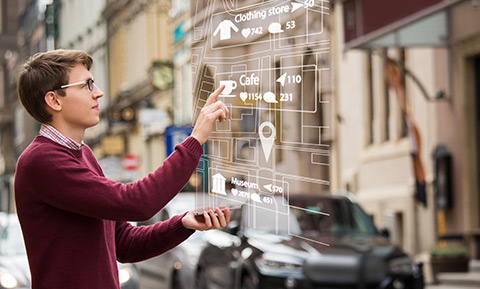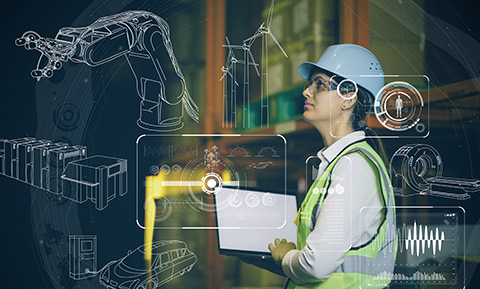Augmented Reality has come a long way from being perceived as a futuristic technology that Dr. Brown from ‘Back to the future’ would be proud of. It’s now considered as an enabler that enhances the perception of everyday life through interactive experiences. While the mandate to handle tasks, processes, systems, and equipment efficiently has always driven AR demand in industries like manufacturing, oil & gas, defence and even to an extent, retail, the supply of partners that truly understand the objectives and deliver an end product that satisfies the end user/ customer had been left wanting. That’s not the case anymore.
9 Real World Applications of Augmented Reality

Advancements in hardware components like processors, sensors and input devices have paved
the way for AR to come within the reach of the hand, literally.
From eyeglasses to
head-mounted displays, from handheld devices like your smartphone to retinal contact lenses,
Augmented Reality is no longer limited to the realms of industrial application but is
accessible to everyone and applicable to a myriad of use cases. Software and algorithms have
taken image registration and processing into greater heights and advancements in SLAM and
projective geometry is making it easier for developers to design an experience that is both
intuitive during interaction and visually appealing in a given environment or
context.
These are truly exciting times for Augmented and Mixed Reality product, solution and service
providers. Various interesting, revenue-generating use cases can be delivered to a larger
audience, having built strong customer support and confidence in the industrial arena.
Here are some use cases or areas that I think Augment reality can fit right in and are worth
investing in:
Healthcare: Projections through Hololens could be used to guide doctors during diagnostic and
therapeutic interventions. It can be used not just in medical training but also during surgical
operations. For example, projecting holograms during image-guided surgery.
City Planning: City planners can build multiple projections to assess projects like traffic
congestion, building structures, disaster planning, etc. and have a 3D mapping of their entire
city at their fingertips.
Architecture: CAD drawings can be superimposed on real structures to ensure accurate
constructions. Architects can also use the 3D projections to not just visualize the project for
themselves but also help their clients understand their illustrations better.
Tourism: For a visitor, the best way to experience a city is through a guide. But what if AR was
the guide? Augmented and mixed reality could be used to simulate historical events, places, and
objects and render it onto the landscape. Fully immersive technology can be used to simulate
your dream destination while you sit in the comfort of your lazy boy.
Education: Imagine having real-life imagery popping out of your textbooks or teachers standing
next to a projected historical event explaining it to the students. I would love to be in that
class! Text, graphics, video, and audio may be superimposed into a student's real-time
environment and help them understand the subject better.
Sales: AR can be used by salespeople to demonstrate the features and benefits of their product
through interactive technology. Virtual demos also reduce the need for creating multiple sales
collateral and the sales team can pitch the product remotely. Imagine a car salesman sending you
a Hololens to view 3 different variants of a car that you are interested in, at home.
Retail and Consumer products: Products on the retail shelf can be synced up to a phone app that
customers can use to scan a marker to get a projection of the product, its manufacturing
process, design elements, benefits, etc. Virtual dressing rooms could help customers try on
various clothing items without having to go into a trial room.
DIY market: Imagine having the ability to perfectly change the oil of your car like a pro
mechanic or assemble the IKEA furniture in minutes instead of looking into the tiny booklet
multiple times to figure out where the screw goes. From gardening to auto enthusiasts, from
construction to art, AR can be the next best friend of a ‘DIY’er.
Art: Artists can build their art in multiple dimensions and get people to completely immerse
themselves in interactive visual arts. Exhibits can be either viewed through apps on one’s
smartphone or through spatial projections.
These are truly exciting times for Augmented Reality. A time of possibilities. A few more
handshakes with customers, consumers and civic bodies should see AR turn the corner.













